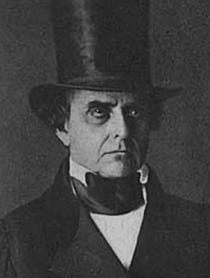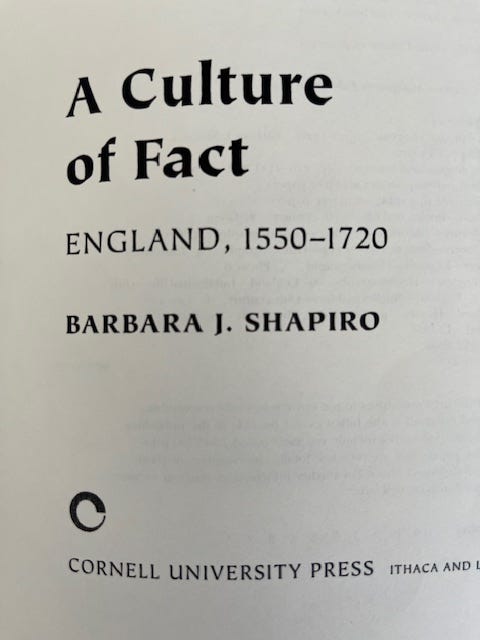As a matter of fact ... a short history of facts
How scholar Barbara J. Shapiro traced the genesis of a surprisingly modern concept
“Now, what I want is Facts. Teach these boys and girls nothing but Facts. Facts alone are wanted in life. Plant nothing else, and root out everything else.” - Mr Gradgrind (Charles Dickens, Hard Times, 1854)
Q: Where would we be without facts? A: Probably somewhere deep in the 14th century.
Facts are the building blocks of our reality. When there’s a war, an accident, a tragedy, an anniversary, a stock market meltdown, a discovery, a celebration, an illness, any kind of legal matter, all aspects of history – we want to know the facts. The who, what, where, when, why, and how.
Of course we do. It’s only natural, right? Armed with the facts, we can plan for the future, avoid danger, understand the risk. As author and teacher Eckhart Tolle said: “Facing facts is always empowering.”
Well maybe it is now, but doing so back in, say, the 14th century, would have been tricky. For the concept of the fact as we now understand it is relatively modern.
I’ve been discovering facts about facts in a brilliant book – A Culture of Fact. England, 1550-1720 - by the late Barbara J Shapiro, former Professor in the Graduate School at the University of California, Berkley. She passed away on December 30, 2022 (more details here - https://jsp-ls.berkeley.edu/news/barbara-shapiro-memoriam)
The notion of historical fact – “a true statement about the past worthy of belief” - is itself a historical development, she writes.
The notion of “fact” or “matter of fact” in the 16th-17th centuries was used to mean “an act or deed performed by a human”. The word “fact” – from Latin “factum” – referred to deeds, feats, and events.
Civil histories were the accounts of the words and deeds of “great men”. “Facts” and “deeds” might be either fictitious or real; and the words “history”, “narrative”, and “story” were often interchangeable.
The classical concept of historia referred to particular happenings, events, and stories “which only sometimes distinguished real happenings from fictional ones”.
Classical history focussed primarily on politics, the state, and war - often written by an experienced statesman or military man - while “rhetorically oriented historians” invented speeches and events and transposed events “in order to provide greater verisimilitude and more effectively instil appropriate lessons”. Cicero, Polybius, Lucian and Tacitus “were frequently cited”.
Early modern historians, she writes, were “also heir to a Christian tradition that emphasised the role of God’s Providence in shaping human affairs”.
‘Purge history of legend and fable’
Over time, some historians – influenced by legal practice - sought to critically evaluate documentary evidence and “to purge history of legend and fable”.
These lawyer-historians “preferred eyewitness accounts to hearsay” and emphasised “the importance of original documents over copies”. Documentary analysis and interpretation “would become more important than first-hand witnessing”.
Mere narrative accounts of facts without causal analysis were “not history, or not good history, or not quite history”.
Factual history, she writes, also implied the rejection of fable, myth and fiction. “This emphasis on truth ended to underline the differences between history and fiction.”
Historical facts, like legal facts, required evidence if they were to be believable, and “it was becoming the obligation of the historian to provide the evidence that would support belief”.
By the 18th century an “historical fact” was considered to be something “which contains nothing that contradicts general experience and our own observation”, and is “supported by the testimony of witnesses” among other things.
Shapiro points out that modern linguistic usage that equates “fact” with “truth” or “reality” had not yet become common.
However, by the end of the 17th Century the “facts” of history were “real”, not imagined, and both history and fact were contrasted “with the fictions of poetry and romance”. The historian’s “permission to invent” was gradually withdrawn; and the playwright, even if he used historical materials, was treated as the creator of works of imagination, not “history”.
Substantial portions of the historical community had incorporated a scholarly tradition that valued accuracy and verification. Historical practitioners worked much harder to ensure that the “facts” they wrote about were “real” and that they were supported by appropriate evidence.
This book is an excellent work of scholarship about the genesis of the “culture of the fact” – something we take for granted exists, but that was not always the case.
Barbara J Shapiro, A Culture of Fact. England 1550-1720, Cornell University Press, Ithaca, New York, 2000.






Sounds like a timely read.